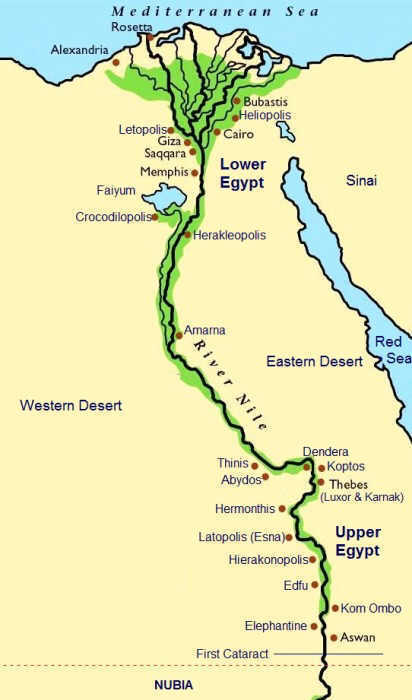Sobek - Reviled or Revered?
The depiction of Sobek as a crocodile god led to him being either being revered as the war-like deity for his strength, power and ferocious attributes or reviled due to his association with the man-eating crocodile. Herodotus an ancient Greek historian (c. 484 – 425 BC) wrote "...those who dwell about the city of Elephantine even eat them, not holding them to be sacred." Sobek the Crocodile God
The crocodile was feared as a vicious man-eater, killing and maiming many people on the banks of the river Nile. Only the adult hippopotamus, which also inhabited the Nile was safe from the crocodile. The Nile Crocodile is the largest crocodile in Africa and can grow up to 20 feet (6 meters) and weigh up to 1,650 pounds (730 kilograms). 
The Family of Sobek
According to one of the many creation myths of ancient Egypt Sobek was believed to be the son of Set, the god of war and hostility and of Neith the warrior goddess of hunting and warfare. The Cult Centers of Sobek
The majority of ancient Egyptians revered Sobek as a patron of the Egyptian army, royal warriors and a defender of the Pharaoh and the Egyptian people and focussed their worship of the god at great temples built at cult centers. Sobek was a major god of Egypt and had political backing leading that led to large followings and cult centers where Sobek was honored with great festivals and processions. His main cult centres were at Crocodilopolis (Shedyet) in Lower Egypt and Thebes & Kom Ombo (Ombos) in Upper Egypt. The following map shows the location of Crocodilopolis, Kom Ombo (Ombos) and Thebes illustrating the widespread worship of Sobek throughout ancient Egypt. Sacred crocodiles were bred and venerated at all of his cult centers dating back to the reign of Amenhotep III (1390 - 1352 BC). 
Map of the Cities of Egypt (Upper Egypt and Lower Egypt) The Cult Centers of Sobek - Crocodilopolis
The ancient city of (Shedyet) in Lower Egypt was named Crocodilopolis meaning "Crocodile City" by the Greeks and was the cult center of Sobek the Egyptian crocodile god who symbolized the might of the Egyptian pharaohs. The region of Faiyum was dominated by a large lake, called Lake Moeris. A temple dedicated to Sobek in Crocodilopolis worshipped a live crocodile, named the sacred Petsuchos, meaning "son of Sobek". The crocodile was worshipped as a manifestation of Sobek and adorned with gold and precious gems and fed the choicest of foods. The crocodile lived in a special temple equipped with sand and a lake. When the Petsuchos died, its carcass was mummified and it was replaced by another. The Greek historian Strabo (63 BC – ca. 24 AD) visited Crocodilopolis and reported that the tamed crocodile Petsuchos was kept in a lake on the temple grounds and was fed grain, pieces of meat, wine and milk mixed with honey brought by foreigners who came to see the divine creature. Herodotus confirmed that anyone, Egyptian or foreigner, who was killed by a crocodile in the district of Crocodilopolis were deemed to be divine and accorded a special funeral conducted by Nile priests, embalmed and buried in a sacred coffin. The Cult Centers of Sobek - Kom Ombo (Ombos)
The cult center of Kom Ombo (Ombos) was located in Upper Egypt. Kom Ombo was originally an Egyptian city called Nubt, meaning City of Gold, was a military base and controlled trade routes from Nubia to the Egyptian Nile Valley. The first, perfectly symmetrical, Kom Ombo temple was built by the pharaoh Tuthmosis III primarily in honor of the crocodile-headed god Sobek but the gods Hathor, Khonsu and Horus the Elder were also worshipped in Kom Ombo. The layout combines two temples in one dedicated to both Sobek and Horus with each side having its own entrances, courtyards, colonnades, altars, halls and sanctuaries. Like Crocodilopolis live crocodiles were kept at the temple of Sobek. A deep well was located near the entrance that supplied the temple with water and a small lake where the crocodiles were raised. Many mummified crocodiles have been found in the temple cemeteries. The Cult Centers of Sobek - Thebes
Karnak, part of the ancient city of Thebes (Luxor), located in Upper Egypt housed a massive temple complex and was primarily the cult center of the Triad of Thebes consisting of Mut, Amun and Khonsu. For additional information refer to the Triads of Egyptian Gods. The Cult Centers of Sobek - Karanis
The long lasting power of Sobek was such that another cult center at Karanis, located in the northeast corner of the Fayum, was established under Roman rule. His worship only fell into decline with the advent of Christianity which was imposed by the Romans by the edict of the Emperor Constantine the Great in 380 when the Christian religion was declared the state church of the Roman Empire. Sobek the Crocodile god of the Military
The ferocious attributes of Sobek led him to become a patron of the Egyptian army, royal warriors and a defender of the Pharaoh and the people of Egypt. It is interesting to note that some ancient Egyptian fortresses had a secured supply of water and were surrounded by crocodile-infested ditches or canals. One such fortress was in Sile (Tjaru) which led, via the major military road (called the Way of Horus) leading out of Egypt, into Canaan and Sinai. The bridge at Sile spanned the crocodile infested waterway - a real deterrent to the enemies of Egypt. |